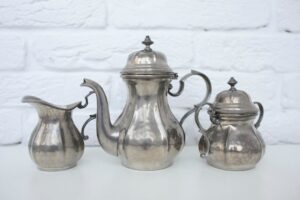A Handy Guide to Tin Alloys
Tin and tin alloys are used in numerous ways. This short but handy guide will help you identify whether a tin alloy is right for your project. View more information on Mayer’s tin alloy offerings here.
Understanding Tin
Tin is a chemical element with the symbol Sn (from Latin: stannum) and atomic number 50. Tin is a silvery metal that has a faint yellow hue. Tin, like Indium, is soft enough to be cut without much force. Pure tin after solidifying keeps a mirror-like appearance similar to most metals, however most solidified tin alloys such as in Pewter have a dull gray color. Tin is a post-transition metal in group 14 of the periodic table of elements and is the 49th most abundant element on earth.
Tin is obtained from a mineral by the name of cassiterite which contains stannic oxide or tin oxide (SnO2). According to the International Tin Association, the top global tin producers are China, Indonesia, Thailand, Malaysia, Bolivia, Peru and Belgium.
Why Tin Alloys are Popular
One of the most important characteristics of tin is the ease with which it alloys or mixes with the majority of other metals. It is this quality together with the low melting point that makes it an essential ingredient of most solder. It is not toxic and it does not corrode easily, making it ideal for protection as a joining metal and when using with food and drinks.
Tin characteristics are also important for making pewter. It’s very high boiling point allows it to be used as a smooth molten surface to make float glass (glass made by allowing it to solidify on molten metal).
The tin wedding anniversary gift celebrates 10 years of marriage. Tin represents durability, flexibility, and protection, making a tin or pewter item perfect gift for such an occasion.
Tin is said to cry when bent because a cracking noise is emitted, some high tin alloys exhibit this property to a lesser extent. A pewter composition gives off a pinging sound as it cools after solidification; this particular alloy contains tin, antimony, copper and bismuth. Alloys of tin, bismuth, lead, and cadmium in the right proportions will melt well below the boiling point of water at just 70C.
Examples of Tin Alloys
 Pewter: Pewter is a malleable metal alloy, typically 85 -95% tin, with the remainder consisting of copper, antimony, bismuth and sometimes, less commonly lead. Silver is also sometimes used. Copper and antimony act as hardeners while lead is common in the lower grades of pewter, which have a bluish tint. It has a melting point, around 338 – 446 F ( 170 -230 C ), depending on the exact alloy. Pewter exploits the beauty and ease of working with tin while other metals are added to provide strength.
Pewter: Pewter is a malleable metal alloy, typically 85 -95% tin, with the remainder consisting of copper, antimony, bismuth and sometimes, less commonly lead. Silver is also sometimes used. Copper and antimony act as hardeners while lead is common in the lower grades of pewter, which have a bluish tint. It has a melting point, around 338 – 446 F ( 170 -230 C ), depending on the exact alloy. Pewter exploits the beauty and ease of working with tin while other metals are added to provide strength.
Bronze: The first tin alloy used on a large scale was bronze, as early as 3000 BC (The beginning of the Bronze Age). Bronze is an alloy consisting primarily of copper, commonly with about 12-12.5% tin and often with the addition of other metals (such as aluminum, manganese, nickel or zinc), and sometimes nonmetals or metalloids such as arsenic, phosphorus or silicon. These additions produce a range of alloys that may be harder than copper alone, or have other useful properties, such as stiffness, ductility, or machinability. Higher tin bronzes are used to cast bells church bells and concert bells (carillons), beside their decorative value, they also offer functional properties, including their permanence and good quality of sound.
Solder: Solder alloy compositions are numerous but most important is still the tin-lead solders which were used by the Romans and are still used today. Tin melts at around 232°C and lead at about 327°C. This composition is known as the eutectic. Solders used in industrial sectors and electronics account for a significant proportion of tin consumption. Lead-free solders also contain tin, along with other metals such as antimony (Sb), bismuth (Bi), silver (Ag) and copper (Cu).
Babbitt Metal or Bearing Metals: Tin has a low coefficient of friction.
This is the first consideration in the manufacturing of bearings., Tin is structurally, a weak metal, and when used in bearing applications it is alloyed with copper and antimony for increased hardness, tensile strength, and fatigue resistance.
Below are some examples of how tin alloys are used. Uses of Tin (International Tin Association)
- Production of lead-based and lead-free solders
- Production of chemicals
- Tin plating
- Manufacturing of lead acid batteries
- Production of copper alloys such as bronze and pewter
- Manufacturing tin cans
- Babbitt material used as bearings for axles and crankshafts
Mayer Alloys is a leading supplier of non-ferrous metals specializing in tin and lead-based alloys and lead-free alloys for manufacturing and/or fabrication. All material is certified to comply with ISO 9001 standards. Customer service and technical assistance is always available to ensure you are getting the right materials. For technical support, please contact us at 844-64-6087, email us at sales@mayeralloys.com or fill out the form in the link below
Request A Quote
To get a quote, please fill out the form below. You can also contact us at 844-564-6087 or via email at sales@mayeralloys.com.
"*" indicates required fields